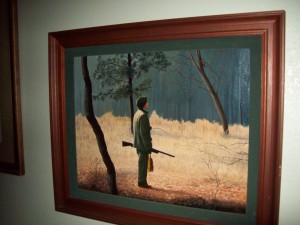Your eyes do not focus like a camera, but we can use the camera as an example of how we focus.
To give you an example of this, I am on the back deck holding my arm out and thumb up and concentrating on a wooden knob on my deck railing ten or twelve feet away. Directly out from me (approximately fifty-feet away) is a maple tree. I am aware of the maple tree but it is not in focus. However, the knob on the railing is in focus. Now I am holding my thumb up and concentrating on the maple tree. It now is in focus while the knob is not.
A camera does not work quite like this. There would be more detail on objects in front of and behind the object you are focusing upon with a photograph. When we draw or paint, as artists we must remember that we are in control with special licenses to imitate life as we wish. But it helps if we use our license intentionally and seldom.
Sometimes as artists we need to alter reality to seem more realistic. For example, when we paint a landscape with trees along an edge and behind each other, we often intentionally paint the tree behind the closer tree more vague and the other one behind that tree even more vague. In reality, the trees may not be that far away from each other. As artists, we do this to create the illusion of depth. If a photograph was taken of this scene, the behind trees would show more detail than we draw or paint into the picture.

In James Frederick’s painting to the left, it is obvious that he wisely used his artist’s license to create the illusion of depth by what he kept vague and what he detailed. It naturally kept our focus on the point of interest.
Tip: To create the illusion of depth, intentionally alter what you are seeing to have the viewer focus on the point of interest.
When you are painting, you can guide your viewers focus with the way you handle the foreground. If the foreground is not the point of interest and is heavy in detail and emphasized, then the point of interest will be understated. However, if the foreground is painted or drawn loose without so much detail then the focus will be on the point of interest.

Of course, I intentionally tried to direct the viewers eyes in this watercolor, Winter Farm. I mostly was experimenting with a loose foreground and directional emphasis. Obviously, I used my artist license to paint this picture.
Tip: To create focus on the point of interest in the middle ground or background, do not use strong detail in the foreground.
Proper use of sharp edges and details will determine what an artist wants their painting to be, what they want their viewers to concentrate upon. We, as artists, must do all the homework it takes to paint a picture. A really good painting will do everything we wish for it to do as far as the viewer is concerned. Overall, it must entertain.
Tip: When drawing or painting, concentrate on the foreground, the middle ground and the background. Make them do what you intend. Define them. Experiment with them.
Challenge: Take a photograph of a scene you think would make a good painting. Print out several black and white copies. Take a graphite pencil and lightly cover segments of the foreground and background around the point of interest. Do not cover over the details completely. Just leave it where the details are more vague. Try it differently with another copy…less or more vague. Keep experimenting while you are emphasizing the point of interest. Enjoy and have fun.

